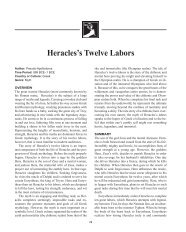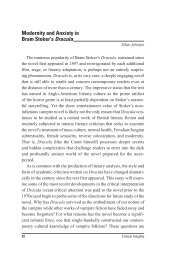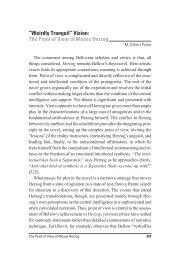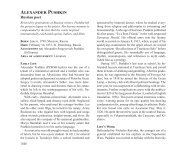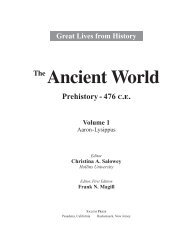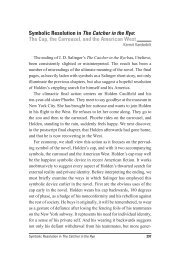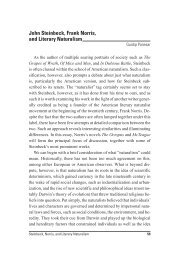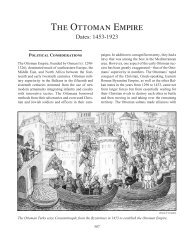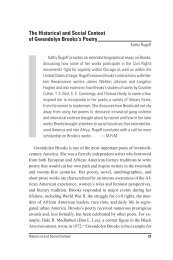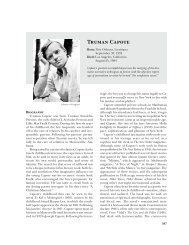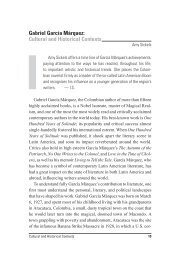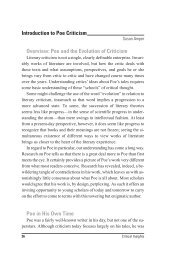“A Fragment of Lost Words”: Narrative Ellipses in The ... - Salem Press
“A Fragment of Lost Words”: Narrative Ellipses in The ... - Salem Press
“A Fragment of Lost Words”: Narrative Ellipses in The ... - Salem Press
You also want an ePaper? Increase the reach of your titles
YUMPU automatically turns print PDFs into web optimized ePapers that Google loves.
While the voice <strong>in</strong> the second passage is still Nick’s, it is Nick’s voice<br />
as lent to Gatsby. <strong>The</strong> third-person pronoun does not change (“he” becomes<br />
“they” as Daisy jo<strong>in</strong>s Gatsby for a moonlit walk), nor does Nick<br />
lose his characteristic lyricism. Yet because the scene is set five years<br />
before Nick met Gatsby, Nick himself is effaced; he is no longer a witness,<br />
but an amanuensis. Stephen Dedalus, Joyce’s young artist, argues<br />
that a narrator should be “ref<strong>in</strong>ed out <strong>of</strong> existence” (Joyce 2000, 119).<br />
Nick approaches such ref<strong>in</strong>ement here. Without chang<strong>in</strong>g pronouns,<br />
Nick changes his relationship to the pronoun. He is not just repeat<strong>in</strong>g<br />
the story Gatsby told him, but retell<strong>in</strong>g that story by apply<strong>in</strong>g some <strong>of</strong><br />
the techniques <strong>of</strong> first person narration to a third person passage, as<br />
here: “His heart beat faster and faster as Daisy’s white face came up to<br />
his own. He knew that when he kissed this girl, and forever wed his unutterable<br />
visions to her perishable breath, his m<strong>in</strong>d would never romp<br />
aga<strong>in</strong> like the m<strong>in</strong>d <strong>of</strong> God” (110). <strong>The</strong> diction and syntax are Nick’s,<br />
but they are bent toward recreat<strong>in</strong>g and br<strong>in</strong>g<strong>in</strong>g to life an event from<br />
Gatsby’s life. This is not quite an <strong>in</strong>stance <strong>of</strong> free <strong>in</strong>direct discourse, for<br />
the “he knew” makes it clear that a narrator is relay<strong>in</strong>g Gatsby’s <strong>in</strong>ner<br />
thoughts. Nor would it be quite fair to say that the po<strong>in</strong>t <strong>of</strong> view has<br />
changed, for Nick is the narrator and Gatsby the character <strong>in</strong> both the<br />
conversation before the ellipses and the imbedded narrative that the ellipses<br />
<strong>in</strong>troduce. Perhaps a better term to apply to the passage is one<br />
co<strong>in</strong>ed by critic Mieke Bal: “focalization.” <strong>The</strong> narrative is focalized<br />
or filtered through Gatsby’s consciousness, and the effect is to elide the<br />
difference between the “I” <strong>of</strong> the narrator and the “he” <strong>of</strong> the character,<br />
so that the one briefly gives way to the other.<br />
Five years ago, Gatsby kissed Daisy and “wed his unutterable visions<br />
to her perishable breath,” while <strong>in</strong> the present day, Nick listens to<br />
Gatsby’s story and f<strong>in</strong>ds some unutterable vision <strong>of</strong> his own flitt<strong>in</strong>g at<br />
the edge <strong>of</strong> his consciousness:<br />
<strong>“A</strong> <strong>Fragment</strong> <strong>of</strong> <strong>Lost</strong> <strong>Words”</strong> 199



